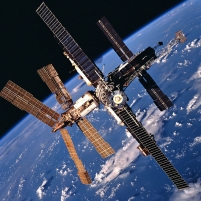Is Space Solar the Solution to World Energy Problems?
Sunday, March 27, 2011
 (graphic: NASA)
(graphic: NASA)
In light of recent energy-related disasters (the nuclear plant in Japan, the BP oil spill in the Gulf of Mexico), advocates are calling for a new approach to generate electricity: space solar power.
First proposed in 1968 by Dr. Peter Glaser, the idea of capturing the sun’s energy in earth’s orbit and beaming it down to the surface seemed far-fetched for many years. But new advances in solar technology make space solar energy a more viable option to consider, proponents say.
Japan, currently suffering with its leaking nuclear power plant, is also leading the way among nations in developing the capability to harness solar energy using special satellites that collect the sun’s rays, convert it into electricity and transmit it to earth using microwave beams and rectify antennas.
Having already committed $21 billion to the project, Japan hopes by 2030 to begin harnessing one gigawatt of energy from space—the same amount that a large nuclear power plant can produce.
-Noel Brinkerhoff
The Race for Space Solar Energy (by William Cox, The Public Record)
About Space Solar Power (National Space Society)
- Top Stories
- Unusual News
- Where is the Money Going?
- Controversies
- U.S. and the World
- Appointments and Resignations
- Latest News
- Trump to Stop Deportations If…
- Trump Denounces World Series
- What If China Invaded the United States?
- Donald Trump Has a Mental Health Problem and It Has a Name
- Trump Goes on Renaming Frenzy






Comments